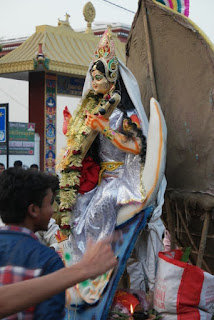Passing by, carried on a flat tray, atop a three wheeler vehicle is a covered statue with several young men squatting and supporting it on its' journey. This is not a singular sight. Idols have been passing by all day. I recognise the statue as Saraswati and learn that it is day one of three for the Saraswati Puja.
Along the side of the road, in makeshift open studios, a mass production of statue has been occurring since I have been in the area. Crafted from straw, string and mud clay, the elaborate creations have been progressively constructed. Sitting between three and six feet high, they are skilfully created in stages. The inner reinforcing is shaped using spliced bamboo, rice straw, tied with string to structure the basic form. Layers of muddy clay are added refining the form and allowed to dry between coats. The sculptor has orders to fill with as many as twenty underway at the same time.
Day by day the form is refined until the last to be added are the fingers in the open facing palm. This is the gesture of bestowing blessings. Sun dried the idols are whitewashed and ready for decoration. This is an elaborate process and is exacting. By sculptures end this idol is temple worthy invested with character, symbolism and faith. She will be worshipped and then ritually destroyed.
Saraswati is the Hindu goddess of knowledge, music, arts, wisdom and learning. She is one of the three main Hindu goddesses with Lakshmi and Parvati who partner the three main gods, Brahma, Vishnu and Shiva, to create, maintain, regenerate and recycle the Universe according to scripture.
Saraswati is depicted sitting on a lotus dressed in white, the symbol of purity. This also represents knowledge and truth. Often there is a swan at her feet - the symbol for discrimination, being able to discern truth from illusion or falsehood.
Indians love colour and these idols and heavily garlanded in marigold, draped with tinselled edged coloured cloth and beautifully painted. Their life is three days after removal from the studio. Lovingly transported they end up in homes, temples and makeshift temples in schools and institutions. The timing of the Puja coincides with spring and the flowering of mustard which often dominates the horizon with vibrant green and golden yellow.
This Puja is important for student who prayer for the qualities this goddess is attributed, mainly knowledge, therefore good results in studies. As a part of their preparation students clean and organise their study materials, books, notes, writing equipment and now-days probably electronic files. On this day they do not study. During the Puja they lay before the idol's feet, notes and texts in the hope that their future will be blessed with success.
Invested with prayer and the hopes of many Saraswati is ceremoniously taken to the closest source of water, be it river or pond, and offered to the waters. The corporeal image is taken by the water, a purification, as it breaks down, ultimately returning to the original elements. The imbued energy released.
In writing this I have counted twelve Saraswati Idols being transported followed by a small group of boys and young men, chanting, moving the hope of their potential future life success, lovingly, devotedly along the street. Not to be confused by the unfortunate soul who left the body today being transported atop shoulders travelling in the opposite direction, equally colourfully garlanded, towards the dry river bed. The drama of life and death constantly playing out and hard to ignore.













No comments:
Post a Comment